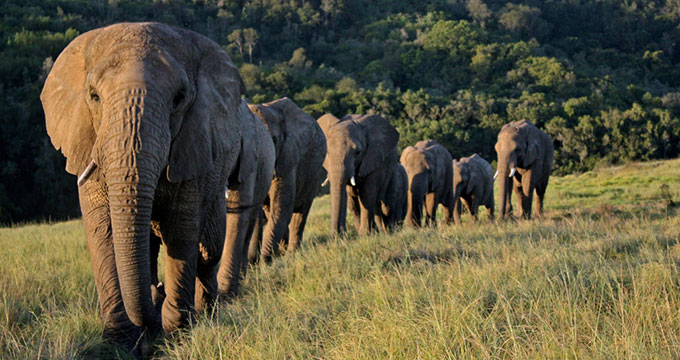
116, Part 2. The Civilized Massacre
On our road out of Cape Town it was sad to see the way that the Cape Flats, the area on the outskirts of the city, had become an extended slum land reaching as far as the airport. Approaching the Hottentots Holland Mountains range and driving over the pass took us into another world of verdant farmlands and manmade forests. Reaching the quaint little town of Swellendam, we made our way to the Bontebok National Park, the smallest of South Africa’s eighteen national parks. Established in 1931, its original purpose was to save the endangered bontebok antelope, with only about thirty of these lovely little animals left. When we filmed there, the park had already increased the herd to well over a hundred. Today, the future of the bontebok remains promising with a number of other parks such as Cape Point acquiring these charming animals and encouraging breeding.
Our next stop was the town of Knysna, situated on the edge of a large lagoon that opens out into the Indian Ocean. It is a combination of retirement homes and a bustling tourism trade. Apart from good beaches and some ideal surfing conditions, the Knysna forest, the largest indigenous forest in southern Africa, stretches along the coast to the north of the town. I have written previously about our perilous encounter with one of the famed Knysna elephants, so will concentrate here more on the “ellies” themselves.
Elephants were indigenous to the entire Cape Province for thousands of years if not longer. The stone age Khoi (Bushman) hunted elephants as well as recording them on many of their rock-art paintings. With the development of the Cape Colony in the 1600s, the elephants were often hunted and killed. The last elephant remaining in the Cape Peninsula was killed in 1704. These wonderful creatures retreated north towards the Knysna-Tsitsikamma forests and beyond to another open plain region called Addo.

Hunting elephants was still considered “jolly good sport” as late as 1867 when Prince Alfred, Queen Victoria’s son and the then-Duke of Edinburgh, led a hunting party to bag some elephants. They killed two and fatally injured two more. There were still an estimated 500 elephants in the Eastern Cape region, but local farmers complained bitterly that these huge pachyderms were destroying their crops, ripping up their fences and generally causing havoc. In 1919, the Administrator of the Cape, Sir Frederic de Waal, was persuaded that the elephants should be exterminated – a largely politically motivated decision.
Famous big-game hunter Major Pretorius was employed to shoot out the elephants. Between June 1919 and August 1920, Pretorius shot 120 of them reducing the known herd in the Knysna forest to sixteen. By the time we arrived in the early ’70s, the forest herd was down to nine. It was rumored that the Knysna elephants were a unique sub-species, possibly the largest in the world. I think that this has been disproved because of their migration from the Southern Cape. However, from personal experience of finding myself some ten yards from a thoroughly irritated Adam, the largest bull in the herd, I have to admit, he was awful big!
Nick Carter, an Englishman famous for being the first man in the world to use an anesthetic dart on a rhino in Kenya, had been commissioned by the local Wildlife Society to research ways of reducing the friction between farmers living on the edge of the forest and the dwindling herd. Nick had semi-retired and had met a lovely lady in Knysna town, so it was an ideal project for him. He was investigating the feasibility of fencing one leg of a triangle in the forest, with the ocean on a second leg and a deep gorge forming the third leg. This was both sensible and cost-effective. The forest elephants, unlike those on the plains, did not roam hundreds of miles foraging for succulent leaves on trees, their staple diet. They would have been content to utilize the area of the triangle which extended for many miles. Sadly, the Forestry Department turned down the plan, claiming that the occasional death of one of the herd caused by irate farmers was not the main reason for the herd’s decline. In their view, the decline was due to the habitat itself and poor dietary opportunities. Despite the protests of Nick and prominent Knysna businessman and writer Hjalmar Thesen, who put us in touch with Nick, the elephant triangle was squashed.
Later, elephants were imported from nearby Addo and even the Kruger Park. The new animals failed to adapt to the forest environment. Today it is claimed that only one female remains in the forest. The authorities have decided to leave her to live her potentially last twenty years of life in the environment she knows best. They claim that she will remain a symbol of the past lamentable policy failures regarding these forest dwellers. This has been disputed by writer and environmentalist Gareth Patterson whose work with lions has been acclaimed internationally. He has now turned his attention to the tragedy of the Knysna elephants and claims that there are, in fact, a number of these wonderful creatures still hiding in the innermost reaches of the forest. I do hope he’s right.
Some people wonder whether this obsession about saving often-obscure various flora and fauna species around the world is worth the effort. Does it matter, for example, if the bontebok become extinct? Is it not more important to concentrate on reducing the harmful effects that we humans have inflicted upon our planet?
In my opinion, both are important – but I personally believe that Man’s efforts at polluting, although desirable, are not necessarily the major cause of climate change. Our planet goes through various cycles over long periods of time. One of the more compelling arguments for natural climate change is polar tilt. I won’t go into all the arguments, but they range from studies showing that from 1995 to 2000 the speed of drift from the previous polar position has increased seventeen times faster than from 1989 to1995. This has resulted in a paltry four-meter drift from southwards to more eastwards. The melting of polar ice is blamed for that – and pollution in turn is blamed for the polar ice melting.
There is also a more dramatic 26,000-year cycle in which Earth makes a significant tilt. We are apparently halfway through this tilt with the axis of the poles aligning with the star Polaris. In another 13,000 years the axis of the poles will align more with the star Vega. I once read a novel which put forward the premise that if the polar ice melts sufficiently, Earth will go through an abrupt and cataclysmic tilt, causing mayhem on the planet.
All I’m trying to say is that nature has a strong hand in affecting our climate as well as the contribution from the humans. Equally, the removal of certain creatures from the highly sophisticated balance of nature can start a chain reaction with significant effects. A prime example of this was the decision to shoot out all the crocodiles in the South African rivers because of the number of people, particularly young children, who were killed every year by crocs. As a result, a large river fish called a barbel or catfish whose numbers had been contained by the crocs started to proliferate in the rivers. The fish have a nasty habit of digging holes into the soft soil of the riverbanks and causing the collapse of the riverine structure itself. It got so bad that the authorities are now breeding crocs and restocking the rivers with them!
I had reached the end of the money available for our initial shoot, so we headed back to Johannesburg. On the way back, Pierre announced that he could not continue with the project. I don’t think it had anything to do with the fright we both got when the huge bull Adam chased us through the forest. It was more that he realized we would have to wait while I found an editor to edit what we had already shot and then seek more money with which to shoot what was still the bulk of the film. I was reasonably happy with the footage we had already acquired, but whether it was enough to get us funded I didn’t know. At any rate I thanked Pierre for his contribution and put my mind on getting the footage edited.
Looking back, I think I took many more chances than most people I knew. I had a wife and four kids but somehow managed to scrape through from month to month as well as keep the family in good shape. We did have some advantages like the house my parents-in-law had given us as a wedding present (a Greek tradition) but I still had to make a living and get the kids into good schools.
As we approach the most exciting stage of the ExoBrain project, with a working model anticipated before the end of the year, I realize how Peter Warren’s dream, although different from mine, required a similar willingness to take chances and not compromise with that dream. It’s taken me many years, but I’ve finally acquired some recognition for my writing skills, just as Peter will acquire global acknowledgement for creating the much-needed paradigm shift in computing when ExoBrain is finally launched.

